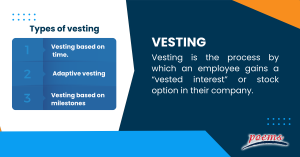Vesting
Table of Contents
Vesting
Many businesses provide employee stock options or restricted shares as a perk for exceeding performance goals or as part of the remuneration package. But you might not immediately see the financial benefits of receiving these such investments.
Your retirement plan or shares must “mature” according to a vesting schedule for you to be able to execute your investment options. What that means and how it could affect your financial planning are explained below.
What is vesting?
Vesting is the process by which an employee gains a “vested interest” or stock option in their company. When an employee has worked for the firm for a predetermined number of years, the corporation will often provide them with a stock option, equity, or employer-specific contribution. As part of the vesting procedure, employers may also contribute to employees’ 401(k) retirement plans.
An employee has non-forfeitable rights to employer-matched retirement funds or stock options after she has reached vesting. A common practice is for an employee’s vested percentage to increase gradually over several years until it reaches 100%. The typical vesting period lasts three to five years.
Understanding vesting
Vested rights in retirement plan benefits give employees an incentive to perform well and stick with a company by granting them access to employer-provided assets over time. When employees fully own an investment, it depends on the vesting schedule the corporation has established.
Employers have access to a powerful weapon for employee retention with vesting within stock bonuses. Vesting may begin right away for some benefits. Employees’ salary deferral contributions to retirement plans, as well as employers’ SEP and SIMPLE contributions, are always fully vesting. Traditional pension plans may feature a three- to seven-year graduated vesting timeline or a five-year cliff vesting schedule.
Benefits of vesting
The benefits of Vesting for employers are:
- Cash availability
Employee pay includes equity and stock options, which also serve as alternatives to monetary bonuses and prizes. They enable the business to keep a larger amount of cash on hand, which can be utilized in emergencies and to settle current debts.
- Vesting conditions
Many top-tier employees may leave or be rejected due to harsh vesting requirements. As a result, drafting a vesting contract requires careful consideration, investment, and thinking.
- The difficulty of vesting plans
Employee time and effort spent designing and implementing vesting schedules may have a large opportunity cost, particularly if the plans are unsuccessful in encouraging employees to stay.
- Lower rate of employee turnover
Companies can guarantee the loyalty and long-term futures with specifically skilled people they wish to retain by offering them the incentive of stock options triggered by time-based milestones.
Types of vesting
The different types of vesting are:
- Vesting based on time.
Time-based vesting is a type of vesting in which employees acquire their share of stock options over time, typically under a predetermined schedule and a cliff, which is the point at which the employee’s first option is given and exercisable. Depending on the vesting schedule, the remaining options are distributed monthly or quarterly after hitting the cliff.
- Adaptive vesting
Time-based vesting and milestone-based vesting are both used in hybrid vesting. In this approach, to be eligible for exercisable stock options, employees must work for the company for a specific period and accomplish a particular objective or milestone.
- Vesting based on milestones
Milestone-based vesting is a vesting in which the employer distributes rewards, such as stock options, in exchange for completing predetermined tasks or achieving predetermined goals.

Example of vesting
To better understand vesting, let’s look at the following example:
Dylan started working for a corporation as a software engineer after receiving 2% of the stock. He had to wait for the vesting term, which was four years, for the stock to become activated. That being the case, he did not get the 2% equity as part of his remuneration plan.
The 2% equity would be worth $400,000 for a business with a $20 million annual revenue. Ronald anticipated that by proving his worth as a company asset over four years, he would earn $100,000 annually. After three years, he was forced to resign due to personal reasons. According to the business plan, Ronald would be given 75% of the shares out of the 2%. The total amount he was awarded was $300,000.
Frequently Asked Questions
Vested interest differs from vesting interest in that vested interest occurs after a specific incident. However, in the case of vesting in interest, the requirement, as mentioned earlier, is extremely ambiguous, and the transfer of property may or may not take place if it is not satisfied.
Employees’ many financial concerns regarding their post-retirement lives can all be addressed via vesting. It is a procedure by which the business reassures its employees that their futures are secure as long as they continue to put in hard work and support its success. Employee rights to assets under employer-sponsored benefit plans, such as stock incentives and pensions based on length of service, are therefore non-forfeitable.
The following are some pros of vesting for both the employee and the employer:
- Since there is no outflow of cash to compensate an employee but rather stock ownership, the corporation does not incur cash payout or expenses.
- The employer benefits by putting people in a position to own a firm asset with a better likelihood of a higher value return at maturity.
- Since the employee’s performance is linked to the vested stock provided as part of the employment contract, the employee has an intrinsic obligation to perform well and meet established milestones.
- Employees are encouraged to stick around in the hopes that they may be eligible for incentives or prizes like vested shares.
- Startups can retain talent by offering modest salaries to talented employees in exchange for further vested stock.
The following are some cons of vesting for both the employee and the employer:
- Vested shares have a complex tax structure that depends on when one decides to buy or sell them and the sort of vesting schedule, which is a drawback.
- The employee runs the risk of losing the vested shares if they leave the company before the end of the vesting period because the vesting is done over a long period.
- Whether progressive or a cliff vested share, benefits may not be paid to newly hired individuals during the first year.
- Since no shares are issued until the vested period expires, the employee with vested share interest is not eligible to receive dividends or to cast a vote at the annual general meeting.
The vesting age is when the insured begins to receive the pension. The insurance starts releasing the annuity payout amount in the frequency specified in the policy once the vesting period is achieved. The vesting age can be changed.
This means that the policyholder can choose when to start receiving the advantages of this investment plan when the policy is first issued. Generally, the minimum and maximum vesting ages are 30 and 80, respectively.
Vesting of shares is the process by which a firm grants its founders or workers shares as part of a compensation package or pension contribution to recognize their contributions to the business and keep them on board for a longer period.
Related Terms
- Margin Requirement
- Pledged Asset
- Stochastic Oscillator
- Prepayment risk
- Homemade leverage
- Prime bank investments
- ESG
- Capitulation
- Shareholder service fees
- Insurable Interest
- Minority Interest
- Passive Investing
- Market cycle
- Progressive tax
- Correlation
- Margin Requirement
- Pledged Asset
- Stochastic Oscillator
- Prepayment risk
- Homemade leverage
- Prime bank investments
- ESG
- Capitulation
- Shareholder service fees
- Insurable Interest
- Minority Interest
- Passive Investing
- Market cycle
- Progressive tax
- Correlation
- NFT
- Carbon credits
- Hyperinflation
- Hostile takeover
- Travel insurance
- Money market
- Dividend investing
- Digital Assets
- Coupon yield
- Counterparty
- Sharpe ratio
- Alpha and beta
- Investment advisory
- Wealth management
- Variable annuity
- Asset management
- Value of Land
- Investment Policy
- Investment Horizon
- Forward Contracts
- Equity Hedging
- Encumbrance
- Money Market Instruments
- Share Market
- Opening price
- Transfer of Shares
- Alternative investments
- Lumpsum
- Derivatives market
- Operating assets
- Hypothecation
- Accumulated dividend
- Assets under management
- Endowment
- Return on investment
- Investments
- Acceleration clause
- Heat maps
- Lock-in period
- Tranches
- Stock Keeping Unit
- Real Estate Investment Trusts
- Prospectus
- Turnover
- Tangible assets
- Preference Shares
- Open-ended investment company
- Standard deviation
- Independent financial adviser
- ESG investing
- Earnest Money
- Primary market
- Leveraged Loan
- Transferring assets
- Shares
- Fixed annuity
- Underlying asset
- Quick asset
- Portfolio
- Mutual fund
- Xenocurrency
- Bitcoin Mining
- Option contract
- Depreciation
- Inflation
- Cryptocurrency
- Options
- Asset
- Reinvestment option
- Capital appreciation
- Style Box
- Top-down Investing
- Trail commission
- Unit holder
- Yield curve
- Rebalancing
- Private equity
- Bull Market
- Absolute Return
- Leaseback
- Impact investing
- Venture Capital
- Buy limit
- Asset stripper
- Volatility
- Investment objective
- Annuity
- Sustainable investing
- Face-amount certificate
- Lipper ratings
- Investment stewardship
- Average accounting return
- Asset class
- Active management
- Breakpoint
- Expense ratio
- Bear market
- Annualised rate of return
- Hedging
- Equity options
- Dollar-Cost Averaging (DCA)
- Due Diligence
- Contrarian Investor
Most Popular Terms
Other Terms
- Physical ETF
- Initial Public Offering
- Buyback
- Secondary Sharing
- Bookrunner
- Notional amount
- Negative convexity
- Jumbo pools
- Inverse floater
- Forward Swap
- Underwriting risk
- Reinvestment risk
- Final Maturity Date
- Payment Date
- Secondary Market
- Mark-to-market
- Yield Pickup
- Subordinated Debt
- Trailing Stops
- Treasury Stock Method
- Bullet Bonds
- Basket Trade
- Contrarian Strategy
- Exchange Control
- Notional Value
- Relevant Cost
- Dow Theory
- Speculation
- Stub
- Trading Volume
- Going Long
- Pink sheet stocks
- Rand cost averaging
- Sustainable investment
- Stop-limit sell order
- Economic Bubble
- Ask Price
- Constant prepayment rate
- Covenants
- Stock symbol
- Companion tranche
- Synthetic replication
- Bourse
- Beneficiary
- Witching Hour
- Widow and Orphan stock
- Public Float
- Closing Price
- Reverse stock splits
- Quiet period
Know More about
Tools/Educational Resources
Markets Offered by POEMS
Read the Latest Market Journal

Back in Business: The Return of IPOs & Top Traded Counters in March 2024
Start trading on POEMS! Open a free account here! At a glance: Major indices continue...

Weekly Updates 15/4/24 – 19/4/24
This weekly update is designed to help you stay informed and relate economic and company...

From $50 to $100: Unveiling the Impact of Inflation
In recent years, inflation has become a hot topic, evoking strong emotions as the cost...

Japan’s Economic Resurgence: Unveiling the Tailwinds Behind Nikkei 225’s Record Leap
Source: eSignal, Intercontinental Exchange, Inc. In the heart of Japan’s economic landscape, the Nikkei 225...

Weekly Updates 8/4/24 – 12/4/24
This weekly update is designed to help you stay informed and relate economic and...

What Makes Forex Trading Attractive?
In a world where the click of a button can send goods across oceans and...

Weekly Updates 1/4/24 – 5/4/24
This weekly update is designed to help you stay informed and relate economic and company...

How to soar higher with Positive Carry!
As US Fed interest rates are predicted to rise 6 times this year, it’s best...












